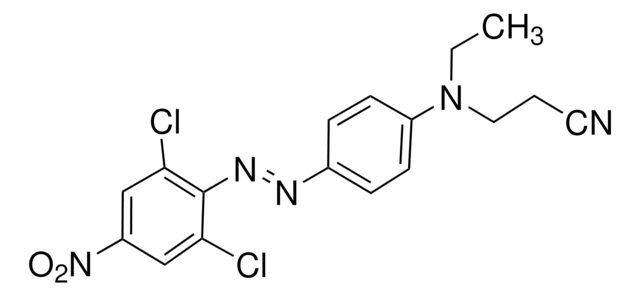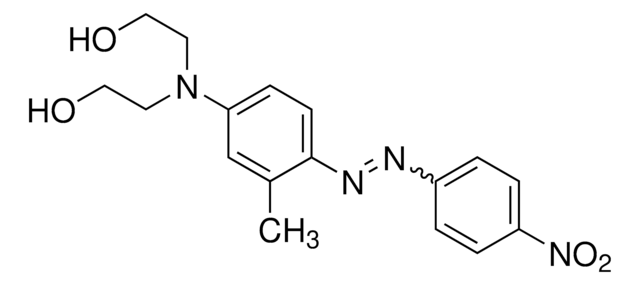364797
Disperse Orange 3
Dye content 90 %
Synonym(s):
4-(4-Nitrophenylazo)aniline
Sign Into View Organizational & Contract Pricing
All Photos(2)
About This Item
Linear Formula:
O2NC6H4N=NC6H4NH2
CAS Number:
Molecular Weight:
242.23
Colour Index Number:
11005
Beilstein:
1842907
EC Number:
MDL number:
UNSPSC Code:
12352103
PubChem Substance ID:
NACRES:
NA.23
Recommended Products
composition
Dye content, 90%
mp
~200 °C (dec.) (lit.)
λmax
443 nm
SMILES string
Nc1ccc(cc1)\N=N\c2ccc(cc2)[N+]([O-])=O
InChI
1S/C12H10N4O2/c13-9-1-3-10(4-2-9)14-15-11-5-7-12(8-6-11)16(17)18/h1-8H,13H2/b15-14+
InChI key
UNBOSJFEZZJZLR-CCEZHUSRSA-N
Looking for similar products? Visit Product Comparison Guide
General description
Disperse Orange 3 (DO3) is a monoazo dye, which contains 90% dye content plus dispersing agents and surfactants. It has two aromatic rings with an amino group on one of the rings and the other is substituted with a nitro group. It shows an absorption peak majoring at 415 nm.
Application
DO3 can be used in low concentration to improve the electro-optic properties of dichroic polymer-dispersed liquid crystals, which can be used as materials for display devices. It can also be used to functionalize epoxy-bisazo based polymers, which can be potentially used in sensors and optoelectronics.
Features and Benefits
Used to provide experimental verification of a two-level model for the enhancement of the nonresonant, nonlinear refractive index, with a decrease in absorption by reduction of a donor group strength.
Signal Word
Warning
Hazard Statements
Precautionary Statements
Hazard Classifications
Eye Irrit. 2 - Skin Irrit. 2 - Skin Sens. 1 - STOT SE 3
Target Organs
Respiratory system
Storage Class Code
11 - Combustible Solids
WGK
WGK 3
Flash Point(F)
Not applicable
Flash Point(C)
Not applicable
Personal Protective Equipment
dust mask type N95 (US), Eyeshields, Gloves
Choose from one of the most recent versions:
Already Own This Product?
Find documentation for the products that you have recently purchased in the Document Library.
Customers Also Viewed
Biodegradation of a model azo disperse dye by the white rot fungus Pleurotus ostreatus.
Zhao X, et al.
International Biodeterioration & Biodegradation, 57(1), 1-6 (2006)
A A Ahmad et al.
Journal of hazardous materials, 170(2-3), 612-619 (2009-06-12)
The purpose of this work is to obtain optimal preparation conditions for activated carbons prepared from rattan sawdust (RSAC) for removal of disperse dye from aqueous solution. The RSAC was prepared by chemical activation with phosphoric acid using response surface
Anthony T-J Goon et al.
Contact dermatitis, 48(5), 248-250 (2003-07-19)
Cross-sensitization between para-phenylenediamine (PPD) and Disperse Orange 3 (DO3), among other textile dyes, has frequently been reported. We evaluated the frequency of simultaneous patch test reactions to PPD and a range of textile dyes. Retrospectively, we studied 128 patients who
Laura Malinauskiene et al.
Contact dermatitis, 68(2), 65-75 (2013-01-08)
Several disperse dyes (DDs) are still considered to be the most important allergens in textile dermatitis, but there are sparse data about their current use in textiles. The aim of this review was to evaluate published studies and reports on
Manfred Kneilling et al.
Experimental dermatology, 19(5), 435-441 (2010-02-02)
Patients sensitized to para-phenylenediamine (PPD) by semi-permanent tattoos increasingly develop threatening allergic reactions in response to black hair dye. The gold standard to diagnose allergic contact dermatitis is to perform epicutaneous patch tests, however, iatrogenic sensitizations and severe patch test
Our team of scientists has experience in all areas of research including Life Science, Material Science, Chemical Synthesis, Chromatography, Analytical and many others.
Contact Technical Service
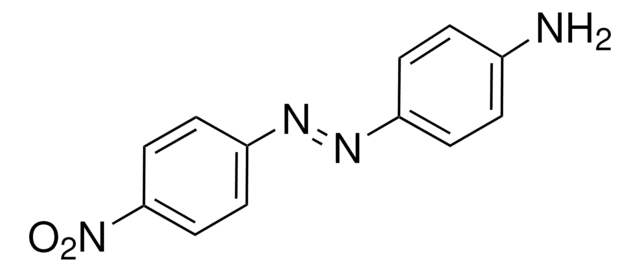

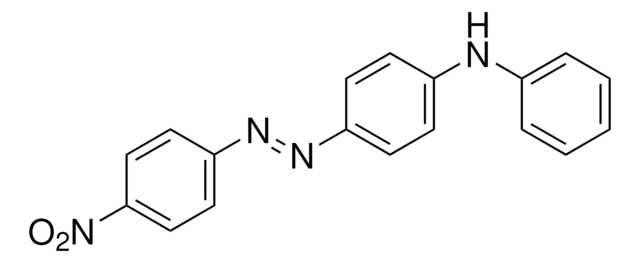
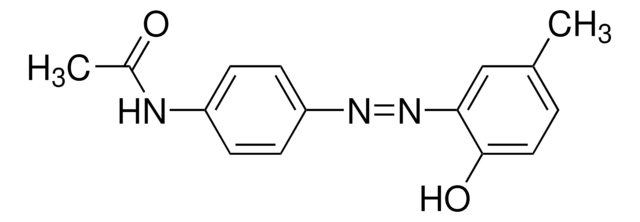


![4-[4-(Dimethylamino)phenylazo]benzoic acid N-succinimidyl ester ≥98.0% (HPLC)](/deepweb/assets/sigmaaldrich/product/structures/120/235/500b5276-3ce2-43b7-9588-3883f13d4ff7/640/500b5276-3ce2-43b7-9588-3883f13d4ff7.png)

